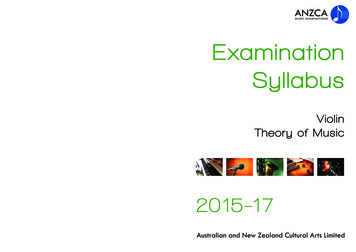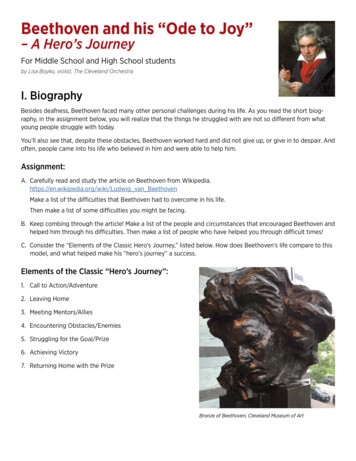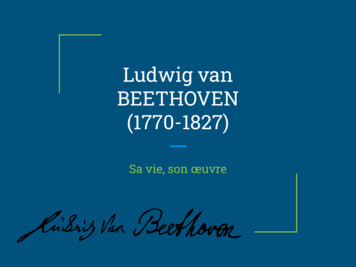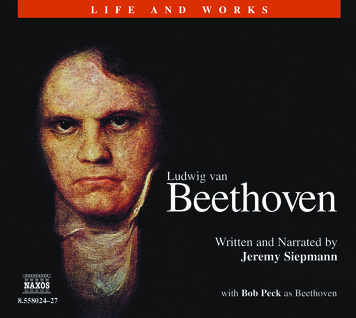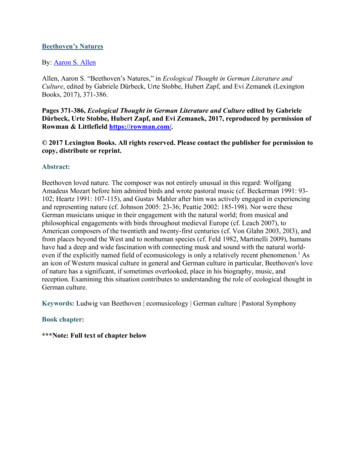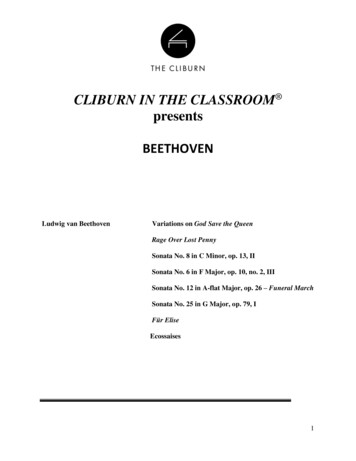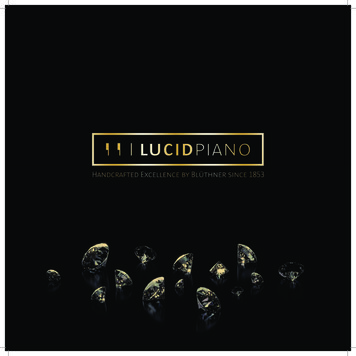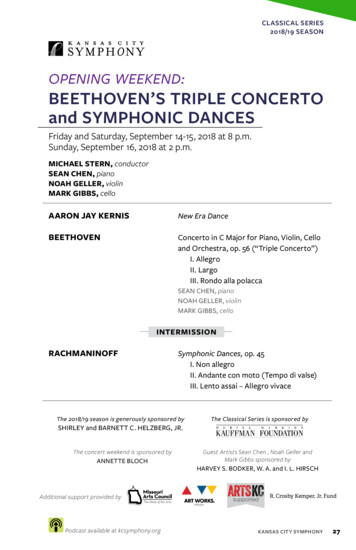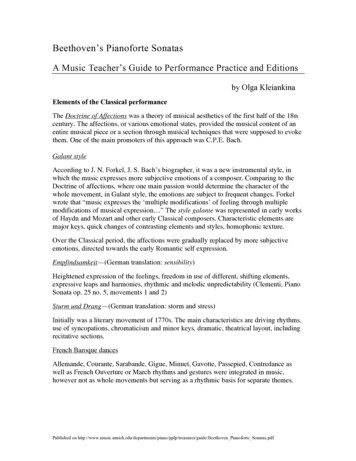
Transcription
Beethoven’s Pianoforte SonatasA Music Teacher’s Guide to Performance Practice and Editionsby Olga KleiankinaElements of the Classical performanceThe Doctrine of Affections was a theory of musical aesthetics of the first half of the 18thcentury. The affections, or various emotional states, provided the musical content of anentire musical piece or a section through musical techniques that were supposed to evokethem. One of the main promoters of this approach was C.P.E. Bach.Galant styleAccording to J. N. Forkel, J. S. Bach’s biographer, it was a new instrumental style, inwhich the music expresses more subjective emotions of a composer. Comparing to theDoctrine of affections, where one main passion would determine the character of thewhole movement, in Galant style, the emotions are subject to frequent changes. Forkelwrote that “music expresses the ‘multiple modifications’ of feeling through multiplemodifications of musical expression ” The style galante was represented in early worksof Haydn and Mozart and other early Classical composers. Characteristic elements aremajor keys, quick changes of contrasting elements and styles, homophonic texture.Over the Classical period, the affections were gradually replaced by more subjectiveemotions, directed towards the early Romantic self expression.Empfindsamkeit—(German translation: sensibility)Heightened expression of the feelings, freedom in use of different, shifting elements,expressive leaps and harmonies, rhythmic and melodic unpredictability (Clementi, PianoSonata op. 25 no. 5, movements 1 and 2)Sturm und Drang—(German translation: storm and stress)Initially was a literary movement of 1770s. The main characteristics are driving rhythms,use of syncopations, chromaticism and minor keys, dramatic, theatrical layout, includingrecitative sections.French Baroque dancesAllemande, Courante, Sarabande, Gigue, Minuet, Gavotte, Passepied, Contredance aswell as French Ouverture or March rhythms and gestures were integrated in music,however not as whole movements but serving as a rhythmic basis for separate themes.Published on treasures/guide/Beethoven Pianoforte Sonatas.pdf
Metronome and the tempo choiceDuring the Enlightment, Renaissance scholars developed a strong interest in antique Greekand Roman writers and the art of rhetoric. Baroque theorists continued this tradition,drawing parallels between rhetoric and music. The art of expressive declamation becamean important element of the German musical tradition (Quantz, C.P.E. Bach).Beethoven grew up within the German rhetoric tradition. He was familiar with the worksof the ancient Roman and Greek orators. He also knew the writings on rhetoric in musicand had listened to performers who incorporated rhetorical style.Authors of theoretical treatises--Turk, Mattheson and others-- saw parallels between thesyntactic forms of language and musical grammar. Commas, colons, semicolons andperiods influence the evolution of the discourse in real time and require fluctuation in thespeed of delivery. Likewise in speech, the musical pulse cannot be exact as the beat of themetronome.The debates about the interpretation of the Beethoven’s music and the role of themetronome still continue. The main confusion draws from C. Czerny’s writings andeditions. Besides the misinterpretation of the articulation, he seems to have been asinconsistent in his metronome markings and tempo interpretation suggestions. His claimsabout tempo giusto and the strict, unvaried metric pulse are often taken literally, whileRies and Schindler advocated Beethoven’s aesthetic approach to music as a freediscourse, based on the rules of declamation and expression. Beethoven was notconsistent in his opinion about the metronome. There is evidence of his excitement aboutthe new device. However, in Biographie, Schindler described one of composer’s angermoments, when he exclaimed:“No more metronome! Anyone who can feel the music right does not need it, and foranyone who can’t, nothing is of any use ”Of all the pianoforte sonatas, only op.106 includes composer’s metronome markings.Fortepiano in Beethoven’s timeViennese modelsSimpler mechanism, small leather-covered hammers and leather dampers result ina light action, with a clear attack, great velocity and a variety of dynamic nuancesand tone color. The decay is quick, the differences in touch and articulation arewell enunciated.English fortepianosThe more complicated mechanism provides bigger resonance. The key action isslower, the touch—heavier.Sound changing mechanisms on earlier instruments were knee levers: damper,una corda and moderators. German manufactures adopted the damper pedal onlyin early 1800sPublished on treasures/guide/Beethoven Pianoforte Sonatas.pdf
Beethoven’s fortepianosEarly period: Stein (after 1810 changed to Stein –Streicher), Walter. Both are Vienneseinstruments with knee levers.1803—Erard with pedals1818—Broadwood1825—Viennese GrafFrom the beginning of his career in Bonn Beethoven has played on fortepianos. Titles as“pour le clavecin ou pianoforte” were used for commercial reasons, while the maininstrument he had in mind was fortepiano.Extension range of Beethoven’s keyboardIn music published before 1804, including the sonatas up to op.53, the generally usedpianoforte range was FF to f3. Although Beethoven already knew larger keyboards, forcommercial purposes he tried to restrict himself in five octaves. Exceptions are:In op.14/1—up to f#3 (1798)In Concerto op.15, f3 was interpreted as f# by analogy in recapitulation1803--Concerto op.37—extended to g3 however cadenza written to c4—Beethovenexpected to receive in a few months a new Erard with a bigger range1808-1810 —including Trios op.70—FF-f41816—op.101—lower register reaches EE1818—op.106—CC, the later Viennese range is CC-f4Notes restorationCompleting top or bottom of the octaves is still debatable especially in cases when addingbass notes on a grand piano may destroy the transparency of the texturePlaces where the composer had to reshape the passagework open new means ofexpression as well as new compositional devices, which seem inappropriate to bechangedPedalBeethoven often created unusual pedal effects with the damper pedal such as in op.31/2/i,op.109/iii, op. 110/iiUna corda effects: op.106/iii, op.111/iiPedal indications in piano sonatas appear with op. 26. However, we know thatBeethoven used much pedal in his playing. Thus, the subtle pedal is to be used carefullyPublished on treasures/guide/Beethoven Pianoforte Sonatas.pdf
throughout, in order to emphasize dramatic points and important harmonies, supportresolutions or help carrying out the long notes.DynamicsThe scale of dynamics of the fortepiano is between mf and mp of a modern piano.Expressing himself, Beethoven often explored extremes in dynamic, ranges, characters,which would often be presented in sudden contrasts. Although he could never obtain aloud enough sound of his fortepianos, he was a great master of the soft nuances. Most ofhis sonatas begin soft and maintain soft dynamics throughout most of the work.Beethoven also liked to hear instrumental or vocal effects as the theme would be sung orplayed by a wind or strings instrumentMissing dynamicsThe lack of dynamic indication at the beginning of the work, according to Turk, Rellstab,Koch and others means a loud start, as the f was a point of reference and any softergradations were indicated. However, f was not a reference any more for Beethoven.Moreover, he preferred soft starts. Whenever not all the dynamics appear in theautograph and in the first editions, Beethoven has left clues. These are: touch orexpression indications, as legato or cantabile, the next appearing dynamics, also thedynamics used when the theme returns.According to S. Rosenblum, the following movements have a quiet start:Op.2/2 Largo: although does not have a dynamic mark in the beginning, however,contains clues for a quiet start :f in m.17, next appearances of the theme in p.Op.49/2—although the start is loud, the texture in the following passage cannot allow bigdynamics otherwise will sound harshTempo di Minuetto—proven to be in other Beethoven’s minuets—is a soft startOp.14/2—ligato and the return of the theme in p indicate a soft nuance at the beginningas wellRepeatsBeethoven considered the repeats as a part of the performance. He was clear where he leftthe choice to the performer (Quartet op.135)AccentsThe German theorist Heinrich Cristoph Koch (1749-1816) distinguished two types ofaccents: grammatical or, metric, and rhetoricDynamic accents in editionsBeethoven was very particular about differences in types of accents.Unfortunately, Czerny, often relying on his memory, gave birth to manyPublished on treasures/guide/Beethoven Pianoforte Sonatas.pdf
misinterpretations and confusions in his editions of the sonatas. Withoutreproducing exactly what the composer wrote, he repeatedly replaced one signwith another, mixing all up sf, fp, rinf and accents. The Urtext editions reproducethe original sources.Performance problemsOn the fortepiano, the accents and rinforzando have a quicker decay. This makesthe fp in the opening of op.13/I logical. On the grand piano a performer needs tofind the ways to adjust in order to produce similar musical effects.The accents were referred to the background dynamic plan: sf within p is differentfrom sf within fAccents, as well as f and ff are not as loud on earlier instruments as on a modernpianoArticulation and touchAround 1800, a new tendency towards legato playing has occurred—the London schoolcomposers—Clementi and Dussek, Field and Cramer, were known for their cantabilelegato style. An explanation for this might be that London pianos had a longer sound.Also, Clementi’s compositions consisted of constantly moving figures, requiring adifferent playing style from the Mozart sonatas.Although Beethoven expanded his legato lines over several bars, the metric articulationwas still used and was notated in the score.Short slurs in accompaniment patterns (op.13/iii)—usually because of the fast tempo areplayed legato throughout. In the early classical period, the slur over a group of 3-4 notesmeans finger pedal for the bass note.Slurs of one or two bars long, which end in the middle of the motive or phrase are writtenby Beethoven. These are not to be interpreted as phrasing slurs but as a tool of carryingout and shaping the phrase: a discrete separation would help maintain the energy andwould make the attack of the note after the slur more distinct. (op. 13/ii, mm.1-8)The first note of the slur receives a certain emphasis as we hear a new distinct attack, thelast notes are lighter, as a release of the gestureStaccato under slur means portato, but also, quoting Charles Rosen, was “a standard wayof indicating an expressive emphasis that was to be performed rubato”Beethoven was very specific about his notation and often was irritated when the editorsor his students misinterpreted his precise articulation. Czerny and other editors of the 19thand the beginning of the 20th centuries, changed Beethoven’s slurs, making them longerto unify the musical sentences or phrases.The question of how the phrasing slur must affect the articulation is still debated amongthe musicologists. (C. Krebs, D.F. Tovey, E. Badura-Skoda versus Schenker, Henleeditions, G. Barth, S. Rosenblum)Published on treasures/guide/Beethoven Pianoforte Sonatas.pdf
The present day critical Urtext editions represent the scores as they appear in the firstsources we have available—manuscript or first editionsNote lengthAs we find from early treatises of C.P.E. Bach and G. Turk, separate notes are not heldthe full value: from ½ to ¾ of the written value. Separate notes lengths increase fromearly Classical towards the Romantic period.OrnamentsThere was no complete agreement on how to perform or notate the ornaments. BesidesClementi and Dussek’s description of the basic elements none of their contemporaries leftexact instructions on the ornament realizationsSmall and long appoggiaturas take their value from the main noteLong appoggiaturas require an expressive resolutionGrace notes and short ornaments—there was little consistency in performing these on thebeat or before. Tutors indicate that most of Beethoven’s short ornaments were playedbefore the beat.Trills—in earlier works start on the upper note. In 1820s the trills were more oftenperformed from the main noteThe choice between long trill, short trill or turn (in cases as a short trill with ending)remains the performer’s choice since Beethoven was not consistent in using signs fortrillsCOMPARING EDITIONSFrequently used editions in chronological order:1842, 1850 98—Krebs1999—Peter Haushild1902—D’Albert2004,2006—Stewart Gordon1931--Craxton/Tovey2007—Barry CooperPublished on treasures/guide/Beethoven Pianoforte Sonatas.pdf
Urtext editions of Schenker, Wallner, Haushild, Gordon, Konemann (Budapest), Cooperreproduce the score exactly as it appears in the earliest sources as autographs or the firsteditions.The following is a comparison of the last bars of the exposition of Sonata op. 2/1 ineditions of Artaria1 (1796, the earliest existing source), Schenker2 (1934) andWallner/Henle3 (1953):1231Beethoven. The 32 piano sonatas: in reprints of the first and early editions, principally from the Anthony van Hoboken Collection ofthe Austrian National Library with prefaces by Dr. Brian Jeffery, London Tecla Editions, c198923Beethoven. Complete Piano Sonatas, Vol. 1-2; edited by Heinrich Schenker, New York, Dover Publications, 1971Beethoven. Klavier-Sonaten, nach Eigenschriften und Originalausgaben hrsg. von B. A. Wallner; Fingersatz von Conrad Hansen,München, Henle, 1952-1953Published on treasures/guide/Beethoven Pianoforte Sonatas.pdf
ArticulationStaccato or wedgeSince the first editors have not been consistent in differences between staccato andwedge, and Beethoven’s autographs in many cases are almost illegible, most of theeditions adopted the staccato dot for both types. The differentiation in editions of Toveyand Schenker does not originate from the first sources. In the performance practice, thelength of the articulation is drawn from the context, texture and the musical expression.The only editors, who are exact in reproducing staccatos and wedges as they appeared inthe earliest sources, are P. Hauschild and B. Cooper.Sonata op.31/1, II, mm. 4-51Simrock, 1803--reprint of the first edition, the earliest source21HauschildBeethoven. The 32 piano sonatas: in reprints of the first and early editions, principally from the Anthony van Hoboken Collection ofthe Austrian National Library with prefaces by Dr. Brian Jeffery, London Tecla Editions, c19892Beethoven. Complete Piano Sonatas, Vol. 1-2; edited by Peter Hauschild, Wiener Urtext edition, Vienna, 2001Published on treasures/guide/Beethoven Pianoforte Sonatas.pdf
Cooper, 2007 Beethoven. Complete Piano Sonatas, Vol. 1-2; edited by Peter Hauschild, Wiener Urtext edition, Vienna, 2001Slurs19th –early 20th century editors, starting with Czerny, introduced phrasing slurs over thearticulation slurs. Since Romantic music tended to have long legato phrases, thedifference between the two types of slurs was not emphasized and gradually disappeared.Thus, the editions as Köhler, Schnabel, Martienssen, Tovey would draw longer legatolines, which can be understood as phrasing slurs, but do not represent correctlycomposer’s indications for the articulation. Some editors also would add a staccato dot atthe end of the slur. Although it does not come directly from Beethoven’s manuscripts, itis a useful guidance in classic performance practice: the last note under a slur is releasedand thus is shorter.Sonata op. 2 no. 1, I, KöhlerL. van Beethoven. Sonates pour piano; revues et doigtées par Louis Köhler & L. Winkler, Braunschweig : H. Litolff ; Boston : A.P.Schmidt, [188-?]Published on treasures/guide/Beethoven Pianoforte Sonatas.pdf
Beethoven. Sonatas for pianoforte; edited by Harold Craxton ; commentaries and notes by Donald Francis Tovey, London AssociatedBoard of the Royal Schools of Music, c1931AccentsCarl Czerny and some early editors freely added extra accent marks besides those existedin the score. However, there are accounts that evidence Beethoven’s strong disagreementwith changes in his manuscripts. Köhler’s edition (1890) reproduces all the accentsexactly. The same can be said about editions of Tovey, Schenker and the editions after1935.PedalBeethoven’s first pedal mark appears in the last bars of the first movement of op. 26.However, his ndication of pedal, probably, could not serve a modern performancebecause there are very few marks, which refer to a specific pedaling or the mostimportant to Beethoven moments in use of pedal effects. Early 20th century editorsincluding Bartok, Schnabel and Tovey used additional pedal marks, which cannot beneglected by pedagogues and students. The abovementioned editors notated theirinterpretation of the score, which was designed to help teaching and learning Beethoven’spiano sonatas.Arthur Schnabel’s editionSchnabel was one of greatest 20th century specialists in Classical music. He also wasamong the first pianists who became interested in early instruments. In his edition, he hasoffered his own interpretation of Beethoven’s sonatas. It helps understanding better hisrecordings and is a good reference for the teachers and students, however not everythingshould not be taken literally. Still, he offers a great variety of articulation for differenttypes of non legato, portato, staccato, accents, according to the character of the music.Schnabel filled-in some missing dynamics (op.2/2/II). It is worth noting that his dynamicsdo not contradict the latest scholarly research on Beethoven’s sonatas. His microdynamic plans within the phrases, character and touch indications reflect his vision of thescore, which is worth to be studied both by beginners and experienced musiciansPublished on treasures/guide/Beethoven Pianoforte Sonatas.pdf
Beethoven. 32 sonatas for the pianoforte. Edited by Artur Schnabel, New York, Simon and Schuster, 1935 [pref. 1953]Phrase slurs create a great confusion and misinterpretation. Editors like Schnabel,Martienssen, Tovey rewrote Beethoven’s articulation without indicating the originalarticulation.Voicing within multiple-voice texture and chords and the ornament realization are selfexplanatory to the students and help understanding the style and the performancepractice.The edition provides exact fingering for all of the passages, chords, ornaments, and this isvery helpful in teaching young students. Schnabel’s fingering is written well pianisticallyand is comfortable even for a smaller hand.Metronome markings and tempo gradations indicate precisely the tempo changes within amovement. However, should they be taken exactly? Tempo changes within themovement, as well as slight fluctuations were a part of performance practice atBeethoven’s time. Schnabel gives a wonderful representation of these fluctuations. Still,literal execution, without an image and an idea behind it, can make the performancemeaningless and unnatural.The same is true of pedaling. There cannot be a recipe of exact places for pedal andrelease. One should assume that pedal is a very delicate component of the performance.Schnabel and the performers of his time mostly used delayed, or syncopated pedal. Thereleases depend on the instrument and the length of the sound it produces. After all, itwould be impossible to write all the gradations from quarter to full pedal. Perhaps, forthese reasons, other editors chose not to include any supplementary pedal.Published on treasures/guide/Beethoven Pianoforte Sonatas.pdf
Beethoven. 32 sonatas for the pianoforte. Edited by Artur Schnabel, New York, Simon and Schuster, 1935 [pref. 1953]Köhler/Ruthardt editionOverall, this edition follows the originals or the first editions except for articulation andextra marks of dynamic gradations. Accents and pedaling are exact. Some of therealizations of embellishments are offered. There are no metronome markings. Missingnotes in octaves are added (op.10/3,I). Sometimes, Köhler proposed an alternative splitbetween the hands for a smaller hand.Craxton/ToveyThe edition follows the original texts with exception of the articulation. Tovey has anindividual approach to the interpretation of the phrasing and articulation. Editorialsuggestions such as supplementary dynamic within the phrase, added notes in octaveswhere the 5-octaves range was exceeded, are in brackets. Pedaling indications are fewerthan in Schnabel’s edition. Some ornaments or appoggiatura realizations are written-out.Every sonata has an introductory essay discussing the tempo, phrasing, character, tonecolor, poetic images. Also, Tovey draws attention to the moments when Beethoven,restricted by 5-octaves range, had to change the phrase shape. (op.10/3/i)Stewart Gordon’s edition is based on the original sources. The main difference fromUrtext editions like Schenker’s or Wallner’s is a broader perspective of the latest researchin performance practices and the availability for comparison of the most important earliereditions. Thus, in the footnotes, there are demonstrated several possibilities for ornamentPublished on treasures/guide/Beethoven Pianoforte Sonatas.pdf
realization, facilitations, articulation discrepancies between the sources. Each opus has anintroductory essay discussing and the formal analysis. The editor’s notes in the beginningtalk about the historical context of Beethoven’s sonatas and the performance issues.Possibly, because of printing, some dynamic gradations or articulation marks are not asexact as in other editions (op.2/1/i). This edition can be recommended as a good teachingedition and source for young musicians.Peter Hauschild’s edition, as well as Gordon’s edition, is one of the most recentlyresearched. This edition is distinctive for its exact reproduction of the original and earlysources. Critical notes are available in a separate volume. This edition is appropriate forprofessional musicians, who know how to interpret the score.Barry Cooper’s critical edition of Beethoven’s 35 sonatas, including WoO numbers, isthe most recent edition available. Each sonata is anticipated by an introductory essay. Theedition highlights Beethoven’s original fingering and composer’s use of staccato andwedge. It also offers the realization of the ornaments. The essays discuss historical andperformance problems, Czerny’s metronome marks are given in the commentary.BibliographyAllanbrook, Wye Jamison. Rhythmic Gesture in Mozart. Chicago: The University ofChicago Press, 1983Barth, George. The Pianist as Orator: Beethoven and the Transformation of theKeyboard Style. Cornell University Press, 1992Drake, Kenneth. The Beethoven Sonatas and the Creative Experience. IndianaUniversity Press, c1994Ratner, Leonard G. Classic Music: Expression, Form and Style. Schirmer Books, c1980Rosenblum, Sandra P. Performance Practices in Classic Piano Music, IndianaUniversity Press, 1988Rosen, Charles. Beethoven's Piano Sonatas. A Short Companion. Yale University Press,New Heaven and London, 2002Beethoven. The 32 piano sonatas: in reprints of the first and early editions, principallyfrom the Anthony van Hoboken Collection of the Austrian National Library with prefacesby Dr. Brian Jeffery, London Tecla Editions, c1989Beethoven. Klavier-Sonaten, nach Eigenschriften und Originalausgaben hrsg. von B. A.Wallner; Fingersatz von Conrad Hansen, München, Henle, 1952-1953Beethoven. Szonáták. Ujjrenddel, az ékesítések kivitelezésével, frazeálással és egyébjegyzetekkel ellátta Weiner Leó. [Sonatas for piano. Fingering, ornaments, phrasing, andPublished on treasures/guide/Beethoven Pianoforte Sonatas.pdf
other remarks by Leo Weiner], Budapest, Zeneműkiadó Vállalat, 1962L. van Beethoven. Sonates pour piano; revues et doigtées par Louis Köhler & L.Winkler, Braunschweig : H. Litolff ; Boston : A.P. Schmidt, [188-?]Beethoven. Sonatas for pianoforte; edited by Harold Craxton ; commentaries and notesby Donald Francis Tovey, London Associated Board of the Royal Schools ofMusic, c1931Beethoven. Sonatas for pianoforte; edited by Barry Cooper, London Associated Board ofthe Royal Schools of Music, 2007Beethoven. 32 sonatas for the pianoforte. Edited by Artur Schnabel, New York, Simonand Schuster, 1935 [pref. 1953]Beethoven. Complete Piano Sonatas, Vol. 1-2; edited by Heinrich Schenker, New York,Dover Publications, 1971Beethoven. Complete Piano Sonatas, Vol. 1-2; edited by Peter Hauschild, Wiener Urtextedition, Vienna, 2001Published on treasures/guide/Beethoven Pianoforte Sonatas.pdf
The Doctrine of Affections was a theory of musical aesthetics of the first half of the 18th century. The affections, or various emotional states, provided the musical content of an . In music published before 1804, including the sonatas up to op.53, the generally used pianoforte range was FF to f3. Although Beethoven already knew larger .
